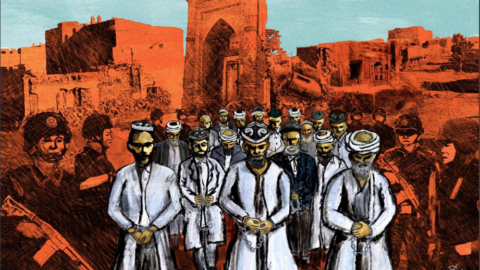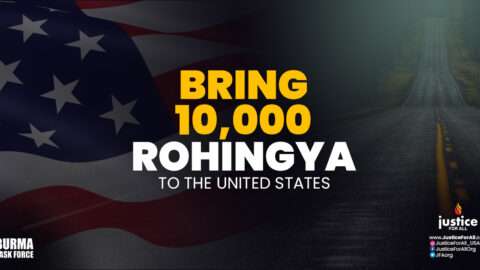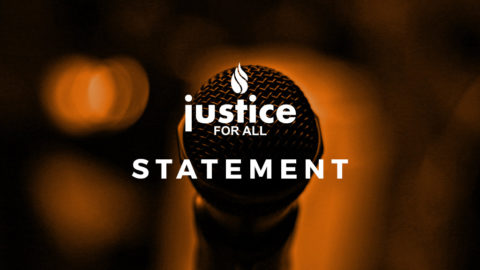Uyghurs and other Turkic peoples in East Turkistan (also known as the Xinjiang Uyghur Autonomous…

Islamophobia in Three Asian Contexts: India, Myanmar (Burma) and China
DOWNLOAD Justice for All Analysis for OHCHR
INTRODUCTION
What is Islamophobia? Serving as conceptual framework for divisive and reactionary politics, the Islamophobic narrative asserts that Islam and Muslims constitute an essential and existential threat both to national security and to national purity. Some scholars[1] have understood this prejudice as arising from an Orientalist power structure, but some of the harshest impacts of Islamophobia exist in Asian nations. Social disruption occurs as each nation struggles with the economic and cultural challenges of adapting to globalization. As Faisal Devji (March 2020)[2] observes, “Increasingly associated with violence in the west… Islamophobia’s brutality is most readily seen in Asia, a continent awaiting its recognition as capitalism’s new home.”
As a human rights advocacy organization, Justice for All[3] advocates for persecuted Muslim minorities with a special focus on the plight of the Rohingya, the Uyghur and the Muslim minorities in India and Kashmir. In each case, a nation’s dramatic opening to new markets has increased opportunities for exploitation. Serving to divide, weaken and exploit a diverse population, those that promote an Islamophobic narrative frequently link it to a securitization framework. Amplifying fears of real and imagined threats, an authoritarian and even paranoid mindset manifests itself both in military force and mob violence.
Therefore, though contributing social and economic factors exist for exclusionary and even genocidal policies in these areas, Islamophobia drives popular support for extreme and destructive social policies, magnified by grassroots social media as well as incendiary speeches by leadership. Thus, Burman Buddhist Supremacist ideology, Han Chauvinism, and the Hindutva movement all serve as tools for elites to manage diverse populations through fear and mutual mistrust.
While this paper will review the character and impact of Islamophobia in these three Asian contexts, we note that like Anti-Semitism, Islamophobia is a global trend. It exists in Europe and in the United States, where it is expressed both in popular stereotypes and in government policies such as the “Muslim Ban,” mass surveillance and counter-terrorism policies that too often conflate religiosity with extremism. However, though the “multicultural” nature of the USA remains contested, and “culture wars” continue to rage, there has been sufficient popular acceptance, economic integration, and legal protection of minorities to withstand the pressure for greater division. With its legacy of slavery, Jim Crow laws and genocidal displacement of Native Americans, the USA offers complex lessons in the messy business of making “one out of many.” And yet, the formal and informal leadership of India, Myanmar and China will each have to find its own political will to embrace difference, pluralism and coexistence.
INDIA
India’s current Prime Minister, Narendra Damodardas Modi, is leader of the Hindu ultra-nationalist BJP party, The BJP party is founded on the Hindutva ideology, a modern rightwing ultra-nationalist formulation first mentioned in V.D. Savarkar’s 1923 book Hindutva, which constructs an idealized Hindu as archetypical citizen of India. Hindutva envisions India to have always been a Hindu nation and perceives Islam and Muslims as an essentially alien force which threaten India through invasion and war. This results in an exclusionary national narrative focused exclusively on the rights of Hindus that marginalizes a number of religious and ethnic identities.
Hindutva is manifested in both extreme and softer forms, ranging from a demand for greater influence of Hindu principles in the state’s decision-making processes to the expulsion, killing, or conversion of all non-Hindus. The fact that India is the largest democracy in the world does not minimize the divisive and discriminatory nature of the BJP and its affinity to a fascistic worldview. Indeed, the BJP party and its main arm, the Rashtriya Swayamsevak Sangh (RSS), were inspired by both Nazi Germany and Mussolini’s fascists in Italy. The RSS was implicated in the assassination of the ‘Father of the Indian Nation,’ Mahatma Gandhi and followers even went as far to stage a re-enactment and celebrate the murder’s success on the 71st anniversary. The BJP’s platform and India’s policies use fear and demonization to target marginalized populations including Christians, Dalits (lower caste Hindus), Muslims, and Sikhs.[4]
In a speech from 2016, the BJP Minister of State for Skill Development and Entrepreneurship stated, “as long as there is Islam in the world, there will be terrorism. Until we uproot Islam, we can’t remove terrorism.”[5] In 2019 BJP President Amit Shah promised, “We will ensure implementation of NRC in the entire country. We will remove every single infiltrator from the country, except Buddha, Hindus and Sikhs.”[6] This threat refers to the National Register of Citizens (NRC) in the state of Assam, used to purge the region and sent 1.9 million now stateless people to detention centers.[7]
Both the 2019 change in Kashmir’s legal status and the intensification of mob violence in the region reflects the spread of Hindutva ideology, which reflects a desire to “take back” the imagined and currently divided homeland. After its first election victory, the BJP party undertook massive purges of voters from the electoral rosters, suppressing voters during the actual elections and violence and intimidation at the polls.
In 2019 the government passed the Citizenship Amendment Act (CAA) which grants fast-tracked Indian citizenship to previously illegal immigrants who entered the country before 2015, and who are Hindu, Sikh, Buddhist, Jain and Parsi, as well as to Christians from Afghanistan, Bangladesh and Pakistan. The act excludes Muslims.
The role of the media and, in particular, social media should not be underestimated as the BJP’s leadership and grassroots have successfully deployed it to deadly consequences. In one example of social media’s role in spreading hate, according to the Indian Express[8], a WhatsApp group was used to plan the riots and attacks against Muslims and others who were in Delhi protesting the Citizenship Amendment Act and the National Register of Citizens.
According to NDTV, by mid-2019, the use of hateful and divisive language by top politicians in India increased by nearly 500 percent since the BJP-led government came to power. NDTV scanned nearly 1,300 articles and cross-referenced this with databases. Researchers went through 1,000 tweets of politicians and public figures.[9]
Disinformation spreads easily on social media[10], for example the false videos alleging that Rohingya Muslim refugees are cannibals that was shared in coordinated posts on WhatsApp and Facebook[11]. Even after these were removed, they were shared again during the 2019 Parliamentary elections. Facebook moderation proved unable to protect minority populations[12]. Rohingya refugees in India have faced violent threats from local leaders, and their refugee camps have been burned.
Responding to anti-Muslim hysteria, additional developments have included the spread of violent cow protection vigilante groups[13] and the embrace of conspiracy theories known as the “love jihad,” ie that Muslim men were systematically stealing Hindu brides, a form of racial and religious panic without factual basis.[14]
The NRC/CAA can be understood as a religious based filter imposed on Indian law. However, there are now other laws such as visa overstay laws that have a religious filter. Muslims who overstay their visa are fined at a much higher rate than non-Muslims. Recently even the Bangladeshi embassy staff who had to leave because of Covid were fined. Hindu staff received very low fines, whereas Muslim staff members were fined at a much higher rate.
Moreover, bail granting procedures for Muslims are often delayed, keeping the journalists or activists in jail for months at end. Non-Muslim media figures such as Arnab Goswami are treated with more deference than Muslim journalists and rights defenders such as Siddique Kappan.[15]
In 2020, the COVID-19 pandemic has been framed as a Muslim problem or another type of “religious” invasion. This framing was articulated in the media as the “CoronaJihad” or “Corona Terrorism,” paradigmatic of populist and ultra-nationalist politicians utilizing crisis to stoke racial, ethnic, and religious tensions. After the Coronavirus hit India, the Modi government announced a sudden lockdown. The Tabligh Jamaat, a Muslim reformist group, was holding a conference in Delhi, with attendees from all over the world. Supporters of the ruling Bhartiya Janata Party began a Social Media campaign targeting Muslims and spread rumors that the Tabligh Jamaat were responsible for spreading Coronavirus in India. Hashtags such as #Coronajihad and #Quranovirus were used to propagate this narrative. There was no attempt by the Modi government to dispel these falsehoods. At the same time, there were also large gatherings in Hindu temples, but it was only the Tabligh Jamaat which was reported negatively on by Indian media.
Yogi Adityanath, the chief minister of Uttar Pradesh state, attended a busy Hindu celebration a day into the lockdown. And 40,000 people in 20 villages were quarantined in Punjab state after a Covid-19 outbreak was linked to a Sikh preacher at a large gathering who had returned from a trip to Italy and Germany, ignoring advice to self-quarantine[16]. And hundreds of thousands celebrated a 10-day temple festival in Kerala state around the same time the gathering in Delhi was happening[17].
The consequences of this disinformation campaign have been great and small. In April 2020, two newborn babies died after hospitals refused to admit their Muslim mothers amid a surge in coronavirus-related Islamophobia.[18]
KASHMIR
The Kashmir region is split between India and Pakistan, which have fought two wars over the territory while claiming the region in its entirety. Since India’s de-facto annexation of Kashmir on August 5, 2019, security forces have arrested thousands of young men, raided people’s homes, inflicted beatings and electric shocks, and threatened to take away female relatives. Thousands of protesters over the past year have been wounded in pellet-gun attacks, including hundreds blinded in one or both eyes. For seven months, until March 2020, the area was under a communications blackout with social media and internet access banned.
As we will see with Rakhine State in Myanmar, and with Xinjiang in the final section, cultural supremacism has been securitized to justify aggressive and comprehensive control of an occupied or colonized region asserting its rights for autonomy and self-determination.[19]
MYANMAR
In Myanmar/Burma, the systematic promotion of Islamophobia has been an important driver of the Rohingya genocide. Spreading hatred on Facebook, over the last ten years the Burmese military and its allies among Buddhist nationalist groups have worked to ensure widespread popular rejection of this Muslim minority.
Despite some grassroots initiatives promoting pluralism and coexistence, this racist and xenophobic rejection arises from a Burmanization movement that marginalizes numerous non-Burman ethnicities but takes special aim at Muslim minorities. The 2015 Race and Religion laws restricting intermarriage with Muslims were enacted because of widespread promotion of a public narrative warning of the threat of “Islamization” ie that Muslims would take over the nation, despite Muslims comprising less than five percent of the population. Even after 740,000 Rohingya Muslims were forced out of Rakhine State by systematic, extremely brutal military attacks in August and September 2017, Buddhist supremacists have claimed that Muslim nations are in a conspiracy to make Myanmar look bad.[20]
While Rohingya have borne the brunt of Islamophobia, losing freedom of movement, loss of access to education, work and voting rights, Muslims throughout Burma have experienced harassment, mosque closures and a hostile atmosphere of suspicion[21]. During the 2020 pandemic[22], Muslims have been arrested[23] and in general faced harsher consequences for violation of curfew than Buddhist or even Christian minorities.[24]
In April 2020, three artists were jailed for three months for their “Coronavirus Awareness” mural which some Buddhist monks perceived as disrespectful.[25] In “The Rise of Religious Offence in Transitional Myanmar” (2019), Iselin Frydenlund has examined the rise of blasphemy laws in Myanmar, and linked them to the post-colonial adaptation of Penal Code laws intended to ensure intercommunal harmony among British imperial subjects. During the decades of dictatorship, the Burmese military government used the same laws to rein in speech, first in a secular, neo-Marxist framework and then appealing to traditional Buddhist values. However, blasphemy is not a sin in traditional Pali Buddhist practice but instead has been manufactured as a category of “religious offence” that is opportunistically employed as a tool of Burman Buddhist domination.
The anthropologist Nick Cheesman has often written insightfully on Burmese social complexity and in his 2017 ‘How in Myanmar “National Races” Came to Surpass Citizenship and Exclude Rohingya’ examines the Burmese concept of approved “national races,” or taingyintha. He notes that, “Ironically, the “surpassing symbolic and juridical power of national races is for people denied civil and political rights at once the problem and their solution.”[26]
The Myanmar Government insists Rohingya are actually “Bengali” ie, foreigners, and only offers identity documentation to that effect. In recent years, the authorities have created a tiered and hierarchical system of rights based less on residency, or place of birth, than on ethnic “nationality.” Scholar Natalie Brinham has studied the impact of these digital identity systems.[27]
The Rohingya have been excluded from the artificial and politicized list of approved nationalities. Rohingya exclusion became formalized after the 2015 national census, funded by the UN’s FPWA and the British Government, among others. Furthermore, in the late 2015 national elections, Rohingya residents were for the first time excluded both from running for office and from voting. Moreover, the NLD party, which won the election quite decisively, refused to run any Muslim candidates in any local race in the nation.
The 2015 NLD success soon brought Aung San Suu Kyi into a power sharing relationship with the military as per the 2008 Constitution, but in addition to presiding over the Rohingya Genocide she has done nothing to reform the Constitution, the Race and Religion Laws, or the 1982 Citizenship Laws that stripped most Rohingya of their citizenship rights. Nor did she speak up for the Rohingya during this time.[28]
In January 2017, State Counsellor Suu Kyi’s longtime advisor Ko Ni was assassinated at Yangon Airport. He was a distinguished lawyer from a Muslim family. After he had publicly criticized the Citizenship Laws and called for constitutional reforms, he had received frequent death threats. Noticeably, Aung San Suu Kyi failed to attend his funeral. While the gunman was arrested, there is evidence of a conspiracy among military intelligence officials. The government has failed to properly respond to these credible allegations.[29]
Facebook is ubiquitous in Myanmar and notoriously has been a vehicle for spreading anti-Muslim hatred. Despite complaints from ATHAN and other civil society coalitions in Myanmar and elsewhere, it took four years for the tech giant to offer appropriate response, such as taking down the pages run by perpetrators of mass atrocities. Even now, Facebook algorithms often do not distinguish between human rights activist websites and promoters of violence. And rather shockingly, Facebook lawyers resist legal requests to share evidence made by lawyers prosecuting genocide in international courts.[30]
Not only have over 350 Rohingya villages been burned and bulldozed, and hundreds of historical monuments, graveyards and mosques been destroyed, but the UN Mapping Unit has followed Myanmar government practice of removing the Rohingya place names from their places of origin. In “Heritage Destruction in Myanmar’s Rakhine State: Legal and Illegal Iconoclasm,”[31] Ronan Lee observes that heritage destruction in Myanmar’s Rakhine state should be understood as part the authorities’ policies of genocide against the Rohingya. He calls on UNESCO to take action. Unfortunately, UNESCO World Heritage Status has, in effect, become a tool for Burman supremacism and other forms of ethno-nationalism, according to scholar Azzezah Kanji,[32] who describes how Myanmar, India and China all commodify traditional cultures for tourist dollars, while persecuting the same minority groups.
CHINA/XINJIANG
In addition to the majority Han population, up to 55 officially recognized “nationalities” live today in China, occupying 60 percent of its territory. Among them, over 23 million practicing Muslims make up less than 2% of the country’s population. Most are Uyghur, a Turkic cultural group, or are labeled as Hui, ethnically similar to the Han ethnic majority. Chinese Muslims are densely clustered in the northwestern regions of Gansu, Ningxia and Xinjiang, but live across the country, as they have for more than a thousand years.
According to National Public Radio (NPR) news reports (November 2020, see below) Muslims in China now fear that religious freedoms are returning to the crisis situation as in the days of the Cultural Revolution in the 1960s and 70s, when signs of religiosity where harshly persecuted. Religious bookstores are being closed across China, mosques are being closed or monitored, and Chinese Islamic associations are being infiltrated by Communist functionaries. NPR quotes a Chinese Muslim publisher comparing the current policies to early oppression: “The persecution we are facing now is worse than that time.”
Last year, NPR reported[33] that authorities had forced nearly all mosques in Ningxia and the eastern province of Henan to “renovate” by removing their domes and Arabic script. Demolitions have since extended to mosques in Zhejiang and Gansu provinces. Imams must now take political education classes as part of a revamped certification program. In addition, in September 2020, at the start of the fall semester, public schools in Sanya began banning female students from wearing headscarves to class. “Videos shared with NPR show the female students being cordoned outside the Tianya Utsul Elementary School because they refused to comply.”[34]
However, it is in Xinjiang that the anti-Muslim policies are most dramatic. Since President Xi Jinping (習近平) came to power, the Chinese Communist Party (CCP) has implemented aggressive social re-engineering efforts targeting Uyghur Muslims in Xinjiang. The government has been up to 2 million Muslims in a vast gulag system of re-education/concentration camps, essentially operating slave labor and brainwashing programs to replace religious beliefs and ethnic culture. As a result of these detentions, tens of thousands of young children have lost contact with their parents, communities and culture.
Although CCP authorities often describe these internment camps as schools, they also liken them to hospitals. This is not the first time China has used medical analogies to suppress a religious minority. “Historically, it’s comparable to the strategy toward Falun Gong,” said Adrian Zenz, a researcher at the European School of Culture and Theology in Germany. A government document published last year in Khotan Prefecture described[35] forced indoctrination as “a free hospital treatment for the masses with sick thinking.”
There is ample documentation leaked from governmental sources that prove the existence of the internment camps. For example, Adrian Zenz analyses 78 re-education facility-related procurement and construction bids, nearly all destined for regions with significant Uyghur or other Muslim populations. Nearly all bids were announced beginning in March 2017, just before the “Regulations on De-extremification” were published.[36]
Chinese authorities in Xinjiang have been collecting DNA samples, fingerprints, iris scans, and blood types of all residents in the region between the age of 12 and 65.[37] This comprehensive collection of biodata challenges the ownership a individual feels over his or her body, now a commodity of the state. Sad to say, the international community is complicit in this.[38]
The increasingly harsh security approach to governing the Uyghur minority over the last twenty years may have had the ‘paradoxical effect of strengthening the central role of Islam in Uyghur life’ and radicalizing its interpretation by Muslim minorities (Fuller and Lipman 2004: 344).
Chinese authorities have long feared that Uyghurs will attempt to establish their own national homeland in Xinjiang, which Uyghur refer to as East Turkestan. In 2009, ethnic riots there resulted in hundreds of deaths, and a small number of Uyghurs have carried out terrorist attacks in the following years. Immediately after this, the CCP increased arrests and disappearances targeting the trained professional class, while initiating the ‘Becoming Relatives’ program, involving CCP cadre homestays in Uyghur homes.
China has destroyed historic Xinjiang mosques[39], shrines and Muslim cemeteries[40]. Meanwhile, to modernize it for tourism, the Chinese government has also destroyed the old city of Kashgar, “the best-preserved example of a traditional Islamic city to be found anywhere in central Asia.”[41]
Scholar Reza Hasmath emphasizes inequalities deriving from Xinjiang’s status as a ‘garrison state’ or ‘internal colony’ in China as an important driver of this oppression[42]. As in Tibet, Han settler activity placed local residents in structural disadvantage by consolidating executive power in the hands of Han officials. However, it is impossible to ignore the prevailing ideology of anti-Muslim chauvinism, even disguised as the “Global War on Terror” with Chinese Characteristics.
The CCP itself authored China’s constitution and laws embracing China’s ethnic, cultural and religious diversity. However, its harsh, inhumanly comprehensive consolidation of state control in Xinjiang and beyond does not conform to those founding principles.
CONCLUSION: NEVER AGAIN?
The 2019 Gert Rosenthal UN Independent Inquiry [43] makes clear how the United Nations failed to stop genocide in Myanmar just as it failed to stop mass atrocities in Sri Lanka. Now, in failing to respond to genocidal and Islamophobic oppression of the Uyghur minority, with atrocity prevention mechanisms, investigations, or sanctions, the United Nations and its member nations undermine Responsibility to Protect (R2P) principles and betray the core values of the UDHR.[44]
END NOTES
[1] https://www.crg.berkeley.edu/research/islamophobia-research-documentation-project/
[2] https://www.theguardian.com/commentisfree/2020/mar/27/xinjiang-germany-islamophobia-global-phenomenon
[4] https://www.uscirf.gov/sites/default/files/India.pdf
[5] https://www.ndtv.com/india-news/union-minister-anantkumar-hegde-cant-wipe-out-terrorism-till-we-uproot-islam-1785351
[6] https://thediplomat.com/2019/05/political-opportunism-in-india-exploiting-islamophobia/
[7] https://www.independent.co.uk/voices/india-narendra-modi-protests-muslim-islamophobia-a9251701.html
[8] https://indianexpress.com/article/cities/delhi/northeast-delhi-riots-whatsapp-group-6488320/ and https://scroll.in/article/942300/explainer-how-whatsapp-was-hacked-to-spy-on-indian-dissidents-and-who-did-it
[9] https://www.ndtv.com/india-news/under-narendra-modi-government-vip-hate-speech-skyrockets-by-500-1838925
[10] https://www.wired.com/story/indias-frightening-descent-social-media-terror/
[11] https://www.equalitylabs.org/facebookindiareport/#key-findings
[12] https://www.aljazeera.com/news/2020/08/15/facebook-ignored-hate-speech-by-indias-bjp-politicians-report/
[13] https://www.hrw.org/news/2019/02/19/india-vigilante-cow-protection-groups-attack-minorities
[14] https://www.equalitylabs.org/facebookindiareport
[15] https://www.aljazeera.com/news/2020/11/13/india-top-court-under-fire-for-bailing-out-divisive-tv-presenter and
https://www.bbc.com/news/world-asia-india-54865071
[16] https://www.bbc.com/news/world-asia-india-52061915
[17] https://www.bbc.com/news/world-asia-india-52147260 and https://www.bbc.com/news/world-asia-india-53165436 and https://www.thedp.com/article/islamaphobia-tweet-engineering-professor-penn-coronavirus
[18] https://www.telegraph.co.uk/news/2020/04/19/indian-hospitals-refuse-admit-muslims-coronavirus-causes-islamophobia/
[19] https://www.justiceforall.org/free-kashmir/ and https://www.aljazeera.com/news/2020/9/25/pakistan-pm-khan-slams-india-over-kashmir-islamophobia and https://iphobiacenter.org/covid-19-and-indias-islamophobia/?fbclid=IwAR2mzehVxjcYMpRb9elbY52QXmmmztDdyQNtWWDi1bC1kgIzXBZk59jiDGY
[20] Myanmar’s Buddhist-Muslim Crisis: Rohingya, Arakanese, and Burmese Narratives of Siege and Fear by John Clifford Holt |
[21] https://www.hrw.org/news/2017/05/08/burma-two-islamic-schools-shuttered-rangoon and http://www.asianews.it/news-en/Three-mosques-closed-near-Yangon-following-threats-by-Buddhist-nationalists-47042.html and https://www.mmtimes.com/news/muslims-seek-reopening-100-mosques-across-country.html
[22] https://www.trtworld.com/magazine/myanmar-blames-the-rohingya-for-covid-19-and-that-s-a-death-sentence-39843
[23] https://www.theguardian.com/world/2017/jun/02/myanmar-muslims-face-charges-for-holding-ramadan-prayers
[24] See p. 9 in our report https://www.justiceforall.org/burma-task-force/report-regarding-icj-ruling-compliance-in-burma-for-may/ and https://www.christianitytoday.com/news/2020/may/myanmar-coronavirus-pastor-arrest-david-lah-persecution.html
[25] https://www.irrawaddy.com/news/burma/artists-freed-anti-buddhist-claims-dropped-covid-19-mural-myanmar.html
[26] DOI: 10.1080/00472336.2017.1297476
[27] https://files.institutesi.org/Locked_In_Locked_Out_The_Rohingya_Briefing_Paper.pdf
[28] Ronan Lee, Islam and Christian–Muslim Relations Volume 25, 2014 – Issue 3: Islam and Muslim-Buddhist and Muslim-Christian relations in Southeast Asia
See also video Is Aung San Suu Kyi An Islamophobe? | Video Documentary
Sept 2019, The Stateless https://www.thestateless.com/2019/06/is-aung-san-suu-kyi-an-islamophobe-video-documentary.html
[29] https://www.reuters.com/investigates/special-report/myanmar-murder-politics/
[30] https://time.com/5880118/myanmar-rohingya-genocide-facebook-gambia/
[31] Journal International Journal of Heritage Studies Volume 26, 2020 – Issue 5
DOI: 10.1080/13527258.2019.1666294
[32] https://www.aljazeera.com/opinions/2019/8/4/how-ethnonationalists-use-the-unesco-world-heritage-label/
[33] https://www.npr.org/2019/09/26/763356996/afraid-we-will-become-the-next-xinjiang-chinas-hui-muslims-face-crackdown
[34] https://www.npr.org/2020/11/21/932169863/china-targets-muslim-scholars-and-writers-with-increasingly-harsh-restrictions
[35]https://www.academia.edu/36638456/_Thoroughly_Reforming_them_Toward_a_Healthy_Heart_Attitude_Chinas_Political_Re_Education_Campaign_in_Xinjiang
[36] https://jamestown.org/program/evidence-for-chinas-political-re-education-campaign-in-xinjiang/
[37] https://www.hrw.org/news/2017/12/13/china-minority-region-collects-dna-millions and
https://www.nytimes.com/2019/12/03/business/china-dna-uighurs-xinjiang.html
[38] https://www.nytimes.com/2019/02/21/business/china-xinjiang-uighur-dna-thermo-fisher.html
[39] https://www.theguardian.com/commentisfree/2019/apr/07/bulldozing-mosques-china-war-uighur-culture-xinjiang
[40] https://www.theguardian.com/world/2019/oct/09/chinas-destruction-of-uighur-burial-grounds-then-and-now
[41] https://www.nytimes.com/2009/05/28/world/asia/28kashgar.html
[42] Hasmath, R January 2019 Central Asian Survey 38(1):46-60 DOI: 10.1080/02634937.2018.1496067 Also see; Future Responses to Managing Muslim Ethnic Minorities in China: Lessons Learned July 2020 Conference: Working Paper.
[43] https://www.un.org/sg/sites/www.un.org.sg/files/atoms/files/Myanmar%20Report%20-%20May%202019.pdf
[44] https://www.un.org/en/universal-declaration-human-rights/
…



